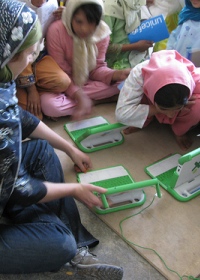What We Really Need for Students with Disabilities
In countries like Afghanistan (where I live) those without disabilities may not be able to access education. The needs of the deaf, blind and those with other disabilities (physical and psychological) are often neglected. For the deaf, communication between parents / teachers and children can be almost impossible and there is a severe shortage of sign language, braille and assistive expertise, never mind the resources to pay for them.
 The first fundamental barrier in the developing world to overcoming disabilities is that we are missing the human capacity we rely on in other parts of the world – the support workers, interpreters, sign language teachers and others. Existing low cost technology can help substitute for this. The XO Laptop, mobile phones and others are suitable low power, low cost hardware and far lower cost than classes ($15/month > 12 months = 1 OLPC) and interpreters for those who would struggle to afford either.
The first fundamental barrier in the developing world to overcoming disabilities is that we are missing the human capacity we rely on in other parts of the world – the support workers, interpreters, sign language teachers and others. Existing low cost technology can help substitute for this. The XO Laptop, mobile phones and others are suitable low power, low cost hardware and far lower cost than classes ($15/month > 12 months = 1 OLPC) and interpreters for those who would struggle to afford either.
What we are lacking is high quality (preferably creative commons or similarly licensed) localized content for both children and adults, such as interactive video sign language courses. Often we lack localized text to speech software. Because parents often can’t afford or can’t find the resources they need to communicate with their children they often find themselves completely excluded, and such frustration can easily foster worse problems.
Using blended learning we can make far more effective use of those limited human resources that we do have, so that classes can be supplemented by more effective self study. Some NGOs are making efforts to provide classes, but they all fall far short of what’s needed.
Here in Afghanistan, a self-instructional sign language application running on the OLPC or other hardware is envisioned that will support parents, children and teachers to learn to communicate with each other. Braille could follow. Our Persian E-Speak has a some work left to go. This will provide the lowest cost most accessible option for people Recognizing psychological disabilities for what they are will likely require cultural changes and shifts that took generations to realize in developed countries.
The hardware is there, the technology exists, with HTML5 we can make platform independent materials that can work on devices from phones to normal desktops to OLPC to PDAs. What we really need is the will, vision and resources to glue it together the content and get it out to those who need it.

"Here in Afghanistan, a self-instructional sign language application running on the OLPC or other hardware is envisioned that will support parents, children and teachers to learn to communicate with each other."
This is a great idea Mike. I heard a similar proposal for Nicaragua from the group from Harvard that went down with to a deaf school in Jan. http://hellolaptop.org/nicaragua.html
I know Kevin who works in Gauladette's IT is also interested. Maybe there is a way to pool resources to create an infrastructure that could be localized.